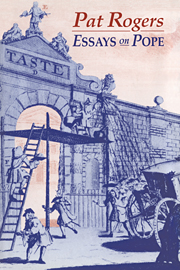Book contents
- Frontmatter
- Contents
- Preface
- Acknowledgements
- List of abbreviations
- 1 Pope and the syntax of satire
- 2 The politics of style
- 3 Form and pattern in the Pastorals
- 4 Windsor-Forest, Britannia and river poetry
- 5 Faery lore and The Rape of the Lock
- 6 Timon's Villa and Chatsworth
- 7 A drama of mixed feelings: the Epistle to Arbuthnot
- 8 The name and nature of Dulness: proper nouns in The Dunciad
- 9 Pope and the social scene
- 10 Blacks and poetry and Pope
- 11 The case of Pope v. Curll
- 12 Pope and his subscribers
- 13 The Burlington circle in the provinces: Pope's Yorkshire friends
- 14 Pope and the antiquarians
- Index
3 - Form and pattern in the Pastorals
Published online by Cambridge University Press: 18 December 2009
- Frontmatter
- Contents
- Preface
- Acknowledgements
- List of abbreviations
- 1 Pope and the syntax of satire
- 2 The politics of style
- 3 Form and pattern in the Pastorals
- 4 Windsor-Forest, Britannia and river poetry
- 5 Faery lore and The Rape of the Lock
- 6 Timon's Villa and Chatsworth
- 7 A drama of mixed feelings: the Epistle to Arbuthnot
- 8 The name and nature of Dulness: proper nouns in The Dunciad
- 9 Pope and the social scene
- 10 Blacks and poetry and Pope
- 11 The case of Pope v. Curll
- 12 Pope and his subscribers
- 13 The Burlington circle in the provinces: Pope's Yorkshire friends
- 14 Pope and the antiquarians
- Index
Summary
I start with a bare computation. In Alexander Pope's Pastorals, as published with minor revisions throughout his lifetime, there are 386 lines. The verse count is ‘Spring’, 102; ‘Summer’, 92; ‘Autumn’, 100; ‘Winter’, 92. However, each of the first three poems is addressed to a named dedicatee, and each has as its second paragraph an invocation to this patron. (‘Winter’ is inscribed to the memory of ‘A Fair Young Lady’, later identified as Mrs Tempest, and has no corresponding paragraph.) These passages run to 10, 4, and 6 lines. If they are excluded the whole work contains 366 verses, a leap-year total which is as exact an approximation to the calendar as a poem in the strictest couplet form can attain. I am aware that this is the sort of arithmetic which gives number symbolism a bad name, and perhaps justly. (‘So they have reached Pope’, some readers may feel.) However, a critic who discovers such a fact ought, I think, to report it; particularly where the implied symbolism resides not in some arcane or deeply submerged correspondence, but in the very nature of the poem's subject matter. Pope's theme is imaged in the bowl described by Daphnis in the opening pastoral:
Four Figures rising from the Work appear,
The various Seasons of the rowling Year.
(‘Spring’ 37–8)I do not wish to press any further on the facts at this stage; merely to observe that Pope never added or deleted lines, as he did in the course of most revisions he undertook.
- Type
- Chapter
- Information
- Essays on Pope , pp. 37 - 53Publisher: Cambridge University PressPrint publication year: 1993

